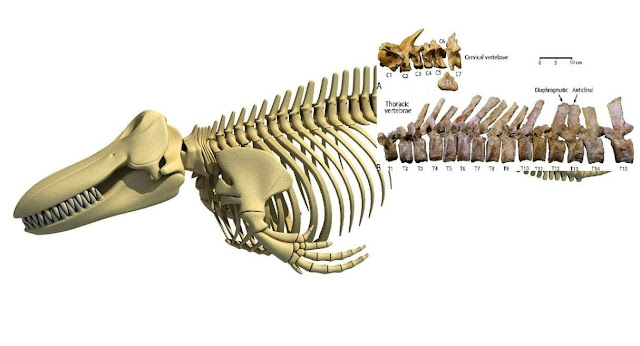How Whales Moved to Life in the Ocean
Jan 11, 2020 7:01:42 GMT -5
grumpybill and RocksInNJ like this
Post by 1dave on Jan 11, 2020 7:01:42 GMT -5
www.geologyin.com/2019/12/ancient-whale-fossil-show-how-mammals.html
Ancient Whale Fossil Show How the Mammals Moved to Life in the Ocean

Cervical and thoracic vertebrae of the Aegicetus gehennae specimen.
Image credits Gingerich et al., , PLOS ONE.
A newly-described fossil whale is helping researchers understand how these mammals transitioned from walking on dry land to swimming in the ocean.
A newly discovered fossil whale represents a new species and an important step in the evolution of whale locomotion, according to a study published in the open-access journal PLOS ONE by Philip Gingerich of the University of Michigan and colleagues.
The fossil record of whale evolution tracks the transition from land-dwelling ancestors to ocean-dwelling cetaceans. Protocetids are a group of early whales known from the Eocene Epoch of Africa, Asia, and the Americas. While modern whales are fully aquatic and use their tails to propel themselves through the water, most protocetids are thought to have been semi-aquatic and swam mainly with their limbs. In this study, Gingerich and colleagues describe a new genus and species of protocetid, Aegicetus gehennae.
The new whale was discovered in 2007 in the Wadi Al Hitan World Heritage Site in the Western Desert of Egypt. It is the youngest-known protocetid, dating to around 35 million years ago, and is known from one exceptionally complete skeleton and a partial second specimen, making it among the best-preserved ancient whales.
Compared with earlier whales, it has a more elongated body and tail, smaller back legs, and lacks a firm connection between the hind legs and the spinal column. These adaptations indicate an animal that was more fully aquatic and less of a foot-powered swimmer than its ancestors.
The body shape of Aegicetus is similar to that of other ancient whales of its time, such as the famous Basilosaurus. These animals appear to be well-adapted for swimming through undulation of the mid-body and the tail, somewhat as crocodiles swim today. The authors suggest that an undulatory swimming style might represent a transitional stage between the foot-powered swimming of early whales and the tail-powered swimming of modern whales.
The authors add: "Early protocetid whales living 47 to 41 million years ago were foot-powered swimmers, and later basilosaurid and modern whales -- starting about 37 million years ago -- were tail-powered swimmers. The late protocetid Aegicetus was intermediate in time and form, and transitional functionally in having the larger and more powerful vertebral column of a tail-powered swimmer."
The above story is based on Materials provided by PLOS.
Ancient Whale Fossil Show How the Mammals Moved to Life in the Ocean

Cervical and thoracic vertebrae of the Aegicetus gehennae specimen.
Image credits Gingerich et al., , PLOS ONE.
A newly-described fossil whale is helping researchers understand how these mammals transitioned from walking on dry land to swimming in the ocean.
A newly discovered fossil whale represents a new species and an important step in the evolution of whale locomotion, according to a study published in the open-access journal PLOS ONE by Philip Gingerich of the University of Michigan and colleagues.
The fossil record of whale evolution tracks the transition from land-dwelling ancestors to ocean-dwelling cetaceans. Protocetids are a group of early whales known from the Eocene Epoch of Africa, Asia, and the Americas. While modern whales are fully aquatic and use their tails to propel themselves through the water, most protocetids are thought to have been semi-aquatic and swam mainly with their limbs. In this study, Gingerich and colleagues describe a new genus and species of protocetid, Aegicetus gehennae.
The new whale was discovered in 2007 in the Wadi Al Hitan World Heritage Site in the Western Desert of Egypt. It is the youngest-known protocetid, dating to around 35 million years ago, and is known from one exceptionally complete skeleton and a partial second specimen, making it among the best-preserved ancient whales.
Compared with earlier whales, it has a more elongated body and tail, smaller back legs, and lacks a firm connection between the hind legs and the spinal column. These adaptations indicate an animal that was more fully aquatic and less of a foot-powered swimmer than its ancestors.
The body shape of Aegicetus is similar to that of other ancient whales of its time, such as the famous Basilosaurus. These animals appear to be well-adapted for swimming through undulation of the mid-body and the tail, somewhat as crocodiles swim today. The authors suggest that an undulatory swimming style might represent a transitional stage between the foot-powered swimming of early whales and the tail-powered swimming of modern whales.
The authors add: "Early protocetid whales living 47 to 41 million years ago were foot-powered swimmers, and later basilosaurid and modern whales -- starting about 37 million years ago -- were tail-powered swimmers. The late protocetid Aegicetus was intermediate in time and form, and transitional functionally in having the larger and more powerful vertebral column of a tail-powered swimmer."
The above story is based on Materials provided by PLOS.







 ... to the New Guys from The ChatBox V.2 Crew
... to the New Guys from The ChatBox V.2 Crew